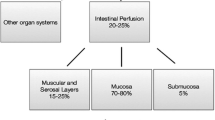Abstract
Background
Burn-induced delayed gastric emptying and intestinal transit limits enteral feeding/resuscitation.
Aims
To study (1) the effects of burn injury on gastric emptying and intestinal transit at different time points following enteral feeding/fluids, and (2) the effects of enteral resuscitative fluids on gastric emptying, intestinal transit, and plasma volume expansion.
Methods
Rats were randomized into sham-burn and burn groups. They were either enterally untreated or treated by a gavage of one or multiple doses of oral rehydration solution (ORS) or, Vivonex®, all mixed with phenol red as a marker, at different time points from 1 to 6 h after burn. Gastric emptying, intestinal transit and hematocrit values were assessed. Gastric emptying of a semi-solid methylcellulose meal served as a standard control for gastric emptying studies.
Results
We found that (1) burn did not alter the gastric emptying of ORS, but delayed its intestinal transit at all time points; (2) burn delayed the gastric emptying of both methylcellulose or Vivonex and the intestinal transit of Vivonex, 6 h after burn; and (3) multiple doses of ORS normalized the elevated post-burn hematocrit values. The percentage of plasma volume expansion at 6 h resulting from the multiple-dose ORS was superior to that of Vivonex by 50%. Addition of Erythromycin to Vivonex improved its gastric emptying, intestinal transit, and plasma volume expansion.
Conclusions
Burn delays the gastric emptying of semi-solids, but not the ORS. Enteral electrolyte solution (ORS) and feeding (Vivonex) provided plasma volume expansion. Prokinetic drugs may be able to maximize the effectiveness of early post-burn feeding.


Similar content being viewed by others
References
Barrow RE, Jeschke MG, Herndon DN. Early fluid resuscitation improves outcomes in severely burned children. Resuscitation. 2000;45:91–96.
Kramer G, Hoskins S, Copper N, Chen JY, Hazel M, Mitchell C. Emerging advances in burn resuscitation. J Trauma. 2007;62:S71–S72.
Cancio LC, Kramer GC, Hoskins SL. Gastrointestinal fluid resuscitation of thermally injured patients. J Burn Care Res. 2006;27:561–569.
Wasiak J, Cleland H, Jeffery R. Early versus late enteral nutritional support in adults with burn injury: a systematic review. J Hum Nutr Diet. 2007;20:75–83.
Wilson RE. Care of the burn patient. Ostomy Wound Manage. 1996;42:16–18, 20–12, 24–16 passim; quiz 35–16.
Sallam HS, Oliveira HM, Gan HT, Herndon DN, Chen JD. Ghrelin improves burn-induced delayed gastrointestinal transit in rats. Am J Physiol Regul Integr Comp Physiol. 2007;292:R253–R257.
Alican I, Coskun T, Yegen C, Aktan AO, Yalin R, Yegen BC. The effect of thermal injury on gastric emptying in rats. Burns. 1995;21:171–174.
Chen CF, Chapman BJ, Munday KA, Fang HS. The effects of thermal injury on gastrointestinal motor activity in the rat. Burns Incl Therm Inj. 1982;9:142–146.
Nguyen NQ, Ng MP, Chapman M, Fraser RJ, Holloway RH. The impact of admission diagnosis on gastric emptying in critically ill patients. Crit Care. 2007;11:R16.
Michell MW, Oliveira HM, Kinsky MP, Vaid SU, Herndon DN, Kramer GC. Enteral resuscitation of burn shock using World Health Organization oral rehydration solution: a potential solution for mass casualty care. J Burn Care Res. 2006;27:819–825.
Suto G, Kiraly A, Tache Y. Interleukin 1 beta inhibits gastric emptying in rats: mediation through prostaglandin and corticotropin-releasing factor. Gastroenterology. 1994;106:1568–1575.
Walker HL, Mason AD Jr. A standard animal burn. J Trauma. 1968;8:1049–1051.
Tollofsrud S, Elgjo GI, Prough DS, Williams CA, Traber DL, Kramer GC. The dynamics of vascular volume and fluid shifts of lactated Ringer’s solution and hypertonic-saline-dextran solutions infused in normovolemic sheep. Anesth Analg. 2001;93:823–831.
Cheever KH. Early enteral feeding of patients with multiple trauma. Crit Care Nurse. 1999;19:40–51; quiz 52–43.
Kramer GC, Michell MW, Oliveira HM et al. Oral and enteral resuscitation of burn shock. The historical record and implications for mass casualty care. J Burns Wound Care. 2003;2.
Schonfeld J, Evans DF, Wingate DL. Effect of viscous fiber (guar) on postprandial motor activity in human small bowel. Dig Dis Sci. 1997;42:1613–1617.
Oliveira HM, Sallam HS, Espana-Tenorio J et al. Gastric and small bowel ileus after severe burn in rats: the effect of cyclooxygenase-2 inhibitors. Burns. 2009.
Xu X, Brining D, Rafiq A, Hayes J, Chen JD. Effects of enhanced viscosity on canine gastric and intestinal motility. J Gastroenterol Hepatol. 2005;20:387–394.
Holt S, Heading RC, Carter DC, Prescott LF, Tothill P. Effect of gel fibre on gastric emptying and absorption of glucose and paracetamol. Lancet. 1979;1:636–639.
Russell J, Bass P. Canine gastric emptying of fiber meals: influence of meal viscosity and antroduodenal motility. Am J Physiol. 1985;249:G662–G667.
Pruitt BA Jr, Mason AD Jr, Moncrief JA. Hemodynamic changes in the early postburn patient: the influence of fluid administration and of a vasodilator (hydralazine). J Trauma. 1971;11:36–46.
El-Sonbaty MA. Oral rehydration therapy in moderately burned children. Ann Mediterranean Burn Club. 1991;4:29–32.
Hoskins SLCN. Fluid resuscitation of burn injury by proctocylsis. J Burn Care Rehabil. 2007;28:S130.
Trocki O, Michelini JA, Robbins ST, Eichelberger MR. Evaluation of early enteral feeding in children less than 3 years old with smaller burns (8–25 per cent TBSA). Burns. 1995;21:17–23.
Chin CL, Fox GB, Hradil VP, et al. Pharmacological MRI in awake rats reveals neural activity in area postrema and nucleus tractus solitarius: relevance as a potential biomarker for detecting drug-induced emesis. Neuroimage. 2006;33:1152–1160.
Conflict of interest
The authors have no conflicts of interest.
Author information
Authors and Affiliations
Corresponding author
Rights and permissions
About this article
Cite this article
Sallam, H.S., Kramer, G.C. & Chen, J.D.Z. Gastric Emptying and Intestinal Transit of Various Enteral Feedings Following Severe Burn Injury. Dig Dis Sci 56, 3172–3178 (2011). https://doi.org/10.1007/s10620-011-1755-2
Received:
Accepted:
Published:
Issue Date:
DOI: https://doi.org/10.1007/s10620-011-1755-2




